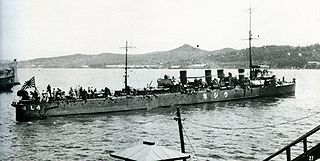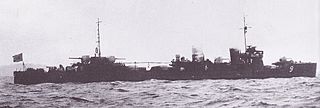See also
| This article includes a list of related items that share the same name (or similar names). If an internal link incorrectly led you here, you may wish to change the link to point directly to the intended article. |
Kamikaze-class destroyer may refer to:
| This article includes a list of related items that share the same name (or similar names). If an internal link incorrectly led you here, you may wish to change the link to point directly to the intended article. |

The Japanese destroyer Hayate was one of nine Kamikaze-class destroyers built for the Imperial Japanese Navy (IJN). During the Pacific War, she was sunk by American coast-defense guns during the Battle of Wake Island in December 1941, the first Japanese warship to be lost during the war. Only a single man of her crew was rescued.

Kisaragi was one of twelve Mutsuki-class destroyers, built for the Imperial Japanese Navy (IJN) during the 1920s. Retreating after the sinking of destroyer Hayate by American coast-defense guns during the Battle of Wake Island in December 1941, Kisaragi was sunk with all hands by American aircraft. She had the distinction of being the second major Japanese warship lost during the war . She should not be confused with an earlier World War I-period Kamikaze-class destroyer with the same name.

The Minekaze class was a class of fifteen 1st-class destroyers of the Imperial Japanese Navy. Obsolete by the beginning of the Pacific War, the Minekaze-class ships were relegated to mostly secondary roles, serving throughout the war as patrol vessels, high speed transports, target control vessels, and as kaiten carriers. Most ultimately were lost to U.S. and British submarines. The basic design of the Minekaze was used for the next three classes of Japanese destroyers, a total of 36 ships.

The Harusame-class destroyers was a class of seven torpedo boat destroyers (TBDs) of the Imperial Japanese Navy. The Harusame class of destroyers were the first destroyers to be built in Japan.

The Kamikaze-class destroyers were a class of nine destroyers of the Imperial Japanese Navy. Some authors consider the Nokaze, Kamikaze and Mutsuki classes to be extensions of the Minekaze-class destroyers, and the Kamikaze class is sometimes referred to as the "Kiyokaze class" to distinguish it from the earlier World War I-era destroyer class of the same name. Obsolete by the beginning of the Pacific War, the Kamikazes were relegated to mostly secondary roles. Most ultimately were lost to U.S. submarines.

Sasebo Naval Arsenal was one of four principal naval shipyards owned and operated by the Imperial Japanese Navy.

Yūkaze was a Minekaze-class destroyer, built for the Imperial Japanese Navy immediately following World War I. Advanced for their time, these ships served as first-line destroyers through the 1930s, but were considered obsolescent by the start of the Pacific War.

Nokaze was the lead ship of the Nokaze sub-class, an improvement to the Minekaze-class 1st class destroyers built for the Imperial Japanese Navy following World War I. Advanced for their time, these ships served as first-line destroyers through the 1930s, but were considered obsolescent by the start of the Pacific War.

Namikaze was the second ship of the Nokaze sub-class, an improvement to the Minekaze-class 1st class destroyers built for the Imperial Japanese Navy following World War I. Advanced for their time, these ships served as first-line destroyers through the 1930s, but were considered obsolescent by the start of the Pacific War. Following the war, the ship was transferred to the Republic of China as a prize of war and renamed Shen Yang.
Numakaze was third and final vessel in the Nokaze sub-class, an improvement to the Minekaze-class 1st class destroyers, built for the Imperial Japanese Navy immediately following World War I. Advanced for their time, these ships served as first-line destroyers through the 1930s, but were considered obsolescent by the start of the Pacific War.

The Mutsuki-class destroyers were a class of twelve destroyers of the Imperial Japanese Navy. All were given traditional poetic names of the months of the year by the Lunar calendar or phases of the moon. Some authors consider the Kamikaze and Mutsuki-class destroyers to be extensions of the earlier Minekaze class.

The Kamikaze-class destroyers("divine wind") were a class of thirty-two torpedo boat destroyers (TBDs) of the Imperial Japanese Navy. The Kamikaze class of destroyers were the first destroyers to be mass-produced in Japan. The class is also sometimes referred to as the Asakaze class. This class of destroyer should not be confused with the later Kamikaze-class destroyers built in 1922, which participated in the Pacific War.

The Enoki-class destroyers were a class of six destroyers of the Imperial Japanese Navy. As with the previous Momo class, all were named after trees. As Enoki and Nara were both commissioned on the same day, the class is also referred to as the Nara-class destroyers.

Harukaze was one of nine Kamikaze-class destroyers built for the Imperial Japanese Navy (IJN) during the 1920s. During the Pacific War, she participated in the Philippines Campaign in December 1941 and the Dutch East Indies Campaign in early 1942. She took part in the Battle of Sunda Strait in March and helped to sink two Allied cruisers.

Satsuki was one of twelve Mutsuki-class destroyers, built for the Imperial Japanese Navy following World War I. Advanced for their time, these ships served as first-line destroyers through the 1930s, but were considered obsolescent by the start of the Pacific War.

The Japanese destroyer Asakaze was one of nine Kamikaze-class destroyers built for the Imperial Japanese Navy (IJN) during the 1920s. During the Pacific War, she participated in the Philippines Campaign in December 1941 and the Dutch East Indies Campaign in early 1942. She took part in the Battle of Sunda Strait in March and helped to sink two Allied cruisers.

The Japanese destroyer Matsukaze was one of nine Kamikaze-class destroyers built for the Imperial Japanese Navy (IJN) during the 1920s. During the Pacific War, she participated in the Philippines Campaign in December 1941 and the Dutch East Indies Campaign in early 1942. She took part in the Battle of Sunda Strait in March before beginning escort duties in Southeast Asia that lasted until mid-1943.

The Japanese destroyer Kamikaze was the lead ship of nine Kamikaze-class destroyers built for the Imperial Japanese Navy (IJN) during the 1920s. At the beginning of the Pacific War in December 1941, the ship was assigned to the Ōminato Guard District. She remained in northern Japanese waters until mid-1942 when she participated in the Aleutian Islands Campaign. Kamikaze continued to patrol northern Japanese waters until early 1945 when she was transferred to the Singapore area.

The Japanese destroyer Hatakaze was one of nine Kamikaze-class destroyers built for the Imperial Japanese Navy (IJN) during the 1920s. During the Pacific War, she participated in the Philippines Campaign in December 1941 and the Dutch East Indies Campaign in early 1942. She took part in the Battle of Sunda Strait in March and helped to sink two Allied cruisers.
Two destroyers of the Imperial Japanese Navy have been named Kamikaze: